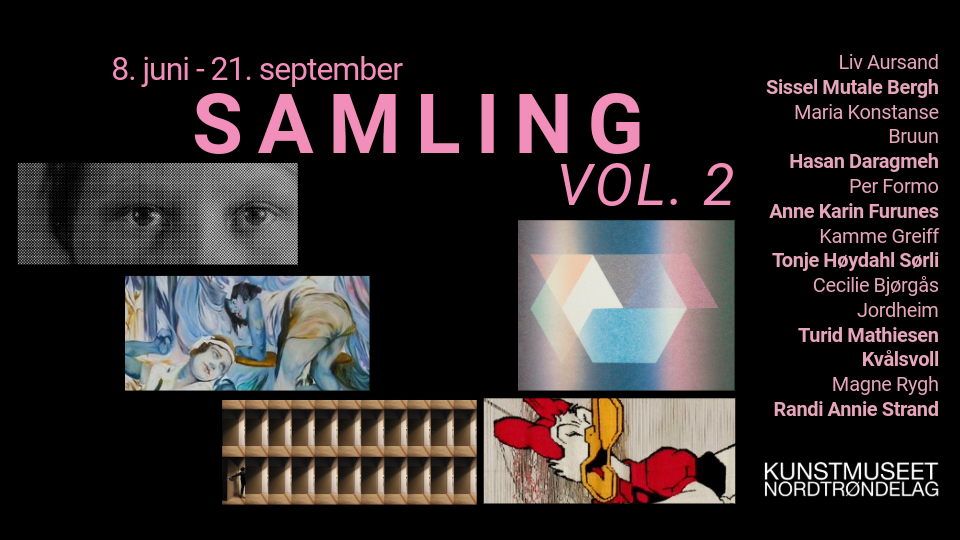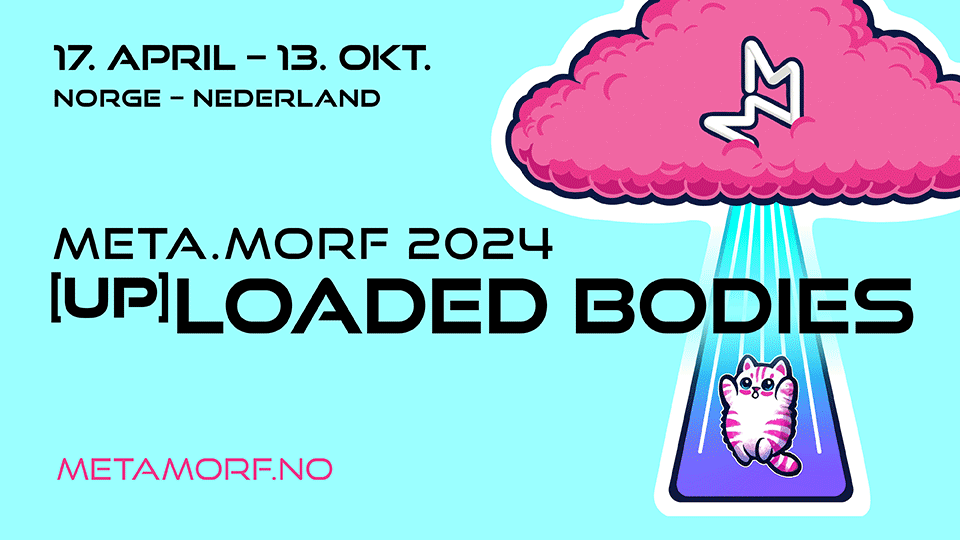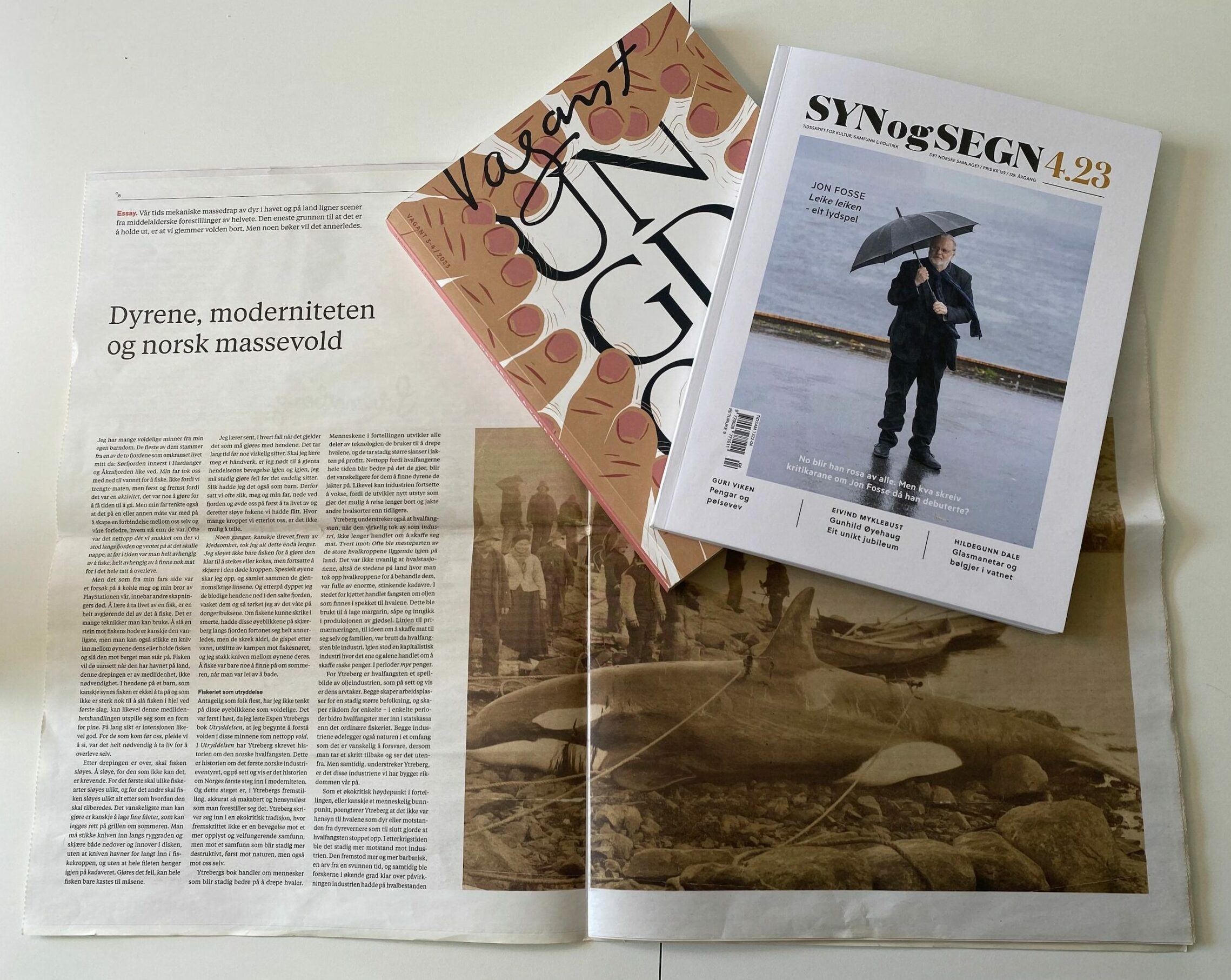Fleeting connections
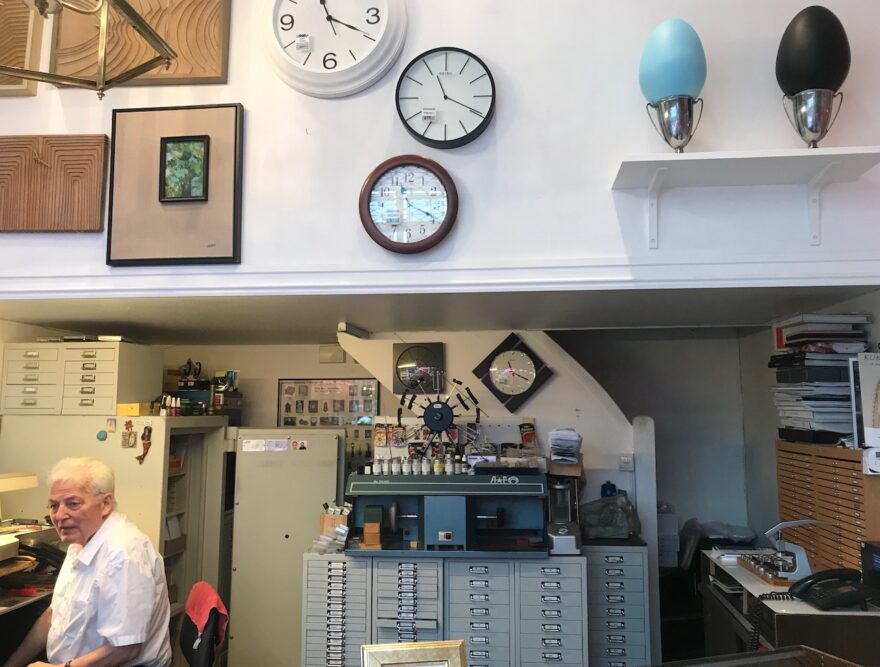
Reviews, Stedsfornemmelser, Text Series, Eline Bjerkan 17.06.2019
I’ve been up and down the stairs inside Oslo Biennial’s administrative headquarters in Myntgata 2 a couple of times now, opening the doors of the small toilets that are located in pairs on the landings between the floors of this four-storey building, and peering inside. A little flustered, I hope no one notices what I’m doing. There’s supposed to be some art here, inside the loos. But I can’t find it.
The Oslo Biennial is curated by Eva González-Sancho Bodero and Per Gunnar Eeg-Tverbakk. This event, which started on 25th May, does not follow the traditional biennial format, but is planned as “a five-year, evolving programme of art in public space”, to be followed by a new period of several years shortly after the first one ends. Participants in the biennial include artists, art teachers and mediators, and academics. They contribute performances, sculptures, sound compositions, mediational strategies, workshops and other art projects that are generally hard to categorise. What the contributions have in common is that they should relate to, or be situated in, the urban space in and around Oslo city centre.
The Oslo Biennale is taking place just as ArtScene Trondheim is sharpening its focus on the role of art in public contexts. In a series of texts, we wish to shed light on the requirements for and distinctive qualities of this type of art, which is of direct relevance to the public. It shapes people’s ideas of what art is, plays a part in the aesthetic aspect of our surroundings and enhances the experience of life and living where we happen to be. In Trondheim, the municipal plan for art in public spaces, the so-called “Trondheim model”, has resulted in more than 250 projects since it was introduced in 2003. One and a quarter percent of the municipality’s total annual investment budget is channelled into this public art scheme. The Oslo Biennial is financed in a similar way, with 0.5% of Oslo council’s investment funds earmarked for art.
One important difference between the two initiatives is already apparent in the terminology they use. While it seemed natural for Trondheim to present the municipal art projects realised in the period 2000–2010 in a publication with the title Kunst ute, kunst inne – en guide til utsmykkinger i Trondheim (Art Outside, Art Inside – A Guide to Decorative Art in Trondheim) (and to release a sequel as early as 2016), the term “decorative art” does not seem entirely appropriate in the case of the Oslo Biennial. The main reason for this is the latter’s focus on processual and temporary art projects, whereas the “Trondheim model” has concentrated largely on permanent and often architectural artworks, where artistic quality is measured primarily in terms of aesthetic parameters. However, this attitude to art in public spaces seems to be changing in Trondheim as well, where there is now a greater willingness to consider temporary art projects, in part in connection with the urban renewal of the Nyhavna industrial district. For this reason, it seems only natural to keep a close eye on Oslo’s ambitious investment in this kind of art.
The public funding model means that Oslo Biennial does not have to compromise itself by running after private sponsorship. By international standards at least, the biennial shows a refreshingly low level of branding and sensationalism. Quite the contrary, it is so unostentatious that locating its headquarters can in itself be something of a challenge. I very nearly ended up at the neighbouring offices of the Oslo Medieval Festival, which was going on at the same time.
Perhaps the lack of sign-posting indicates that the biennial is aimed primarily at Oslo’s own population. In the preface to a booklet presenting the biennial, director Ole G. Slyngstadli expresses the hope that the event will “help the people of Oslo to take ownership of their own environment to an even greater extent”, adding that reaching out to an international audience is something that must follow on from this. It’s a grand idea, but Slyngstadli and Eeg-Tverbakk seem to contradict it when, in an interview with Morgenbladet*, they explain that the biennial title was chosen to attract international attention. One also has the impression that Slyngstadli believes that by calling the event a biennial, they are simultaneously raising questions about that format.

The slightly woolly meta-perspective is also apparent in Lisa Tan’s toilet art, which I mentioned at the outset. Her contribution is quite simply a new refurbishment of the toilets serving the temporary artists’ studios in Myntgata 2. Here, the wood trims have been painted and new tiles laid. The aim, I am told, is to “give something back to the artists”. Tan’s work is also illustrative of the consequences of Oslo Biennial’s approach; the curators seem to prioritise the freedom and wishes of the participating artists, with regard to themes, form and context. During the opening weekend, González-Sancho Bodero explained that they wanted to avoid a “top-down” mentality in their dealings with the artists. The programme also juxtaposes the contributions of artists with those of other cultural workers, an approach that tends to blur the distinction between the art and art mediation. Further, the biennial acknowledges that it takes time to produce art, and that art in public space often evolves slowly in response to the respective environment. In conversation with Kunstkritikk, the curators have said that they intend the Oslo Biennial to be an “artist-friendly” event.
This shows a generous spirit, and few would begrudge the artists decent working conditions, reasonable remuneration and tasteful sanitary facilities. At the same time, by focusing on process and production, the biennial is distancing itself from a museum or event-type format, which can in itself be a fruitful starting point. But, when production and mediation procedures of every kind are themselves presented as artistic products, in a well-meant attempt to demystify the art, the result can appear paradoxically introverted, self-absorbed and obscure even to the local, Oslo-based audience. Here it seems reasonable to point out that by disavowing every possible authoritarian stance, one risks doing a disservice to the artists, art and audiences alike.
When the permissive approach that the Oslo Biennial seeks to cultivate does succeed, however, the result can be a unique and meaningful experience. The foundation for this is the efforts of artists to engage in active dialogue with their surroundings. For me personally, the eye-opening moment in this respect came when I went looking for a work by the American Michael Ross, which was supposedly located in the shop of the watchmaker Ossur Soleim. Ross has created three works for the biennial: one for the open-air space in front the biennial’s headquarters in Myntgata, another for Norlis Antiquarian bookshop, and the third, the one situated in the Ossur Soleim shop, which consists of two egg-shaped sculptures, one blue, one black, entitled The Longest Day and the Longest Night.
As chance would have it, I wandered into a different watchmaker’s store before finding the correct one. This was the kind of place that will happily lighten your purse of a month or two’s earnings before you leave. I mumbled something about an artwork, the Oslo Biennial and art in public spaces, which failed to make either myself or the well-groomed ladies behind the counter any the wiser. As a result, the sense of stepping into another world was all the stronger when I found the right watchmaker just around the corner. Here it seemed that time had stood still. A white-haired man sat bent over a cluttered workbench, flanked by piles of equipment, filing cabinets and clocks of every conceivable kind. Eventually, after explaining to him my errand, my attention was drawn to The Longest Day and the Longest Night amid the welter of objects. Although he seemed busy, he took a moment to tell me a thing or two about Ross’ work. The wrong turnings and coincidences, together with the conversation with the watchmaker, can all be seen as organic elements of such an artwork. In some cases the context makes a bigger impression than the actual art object.
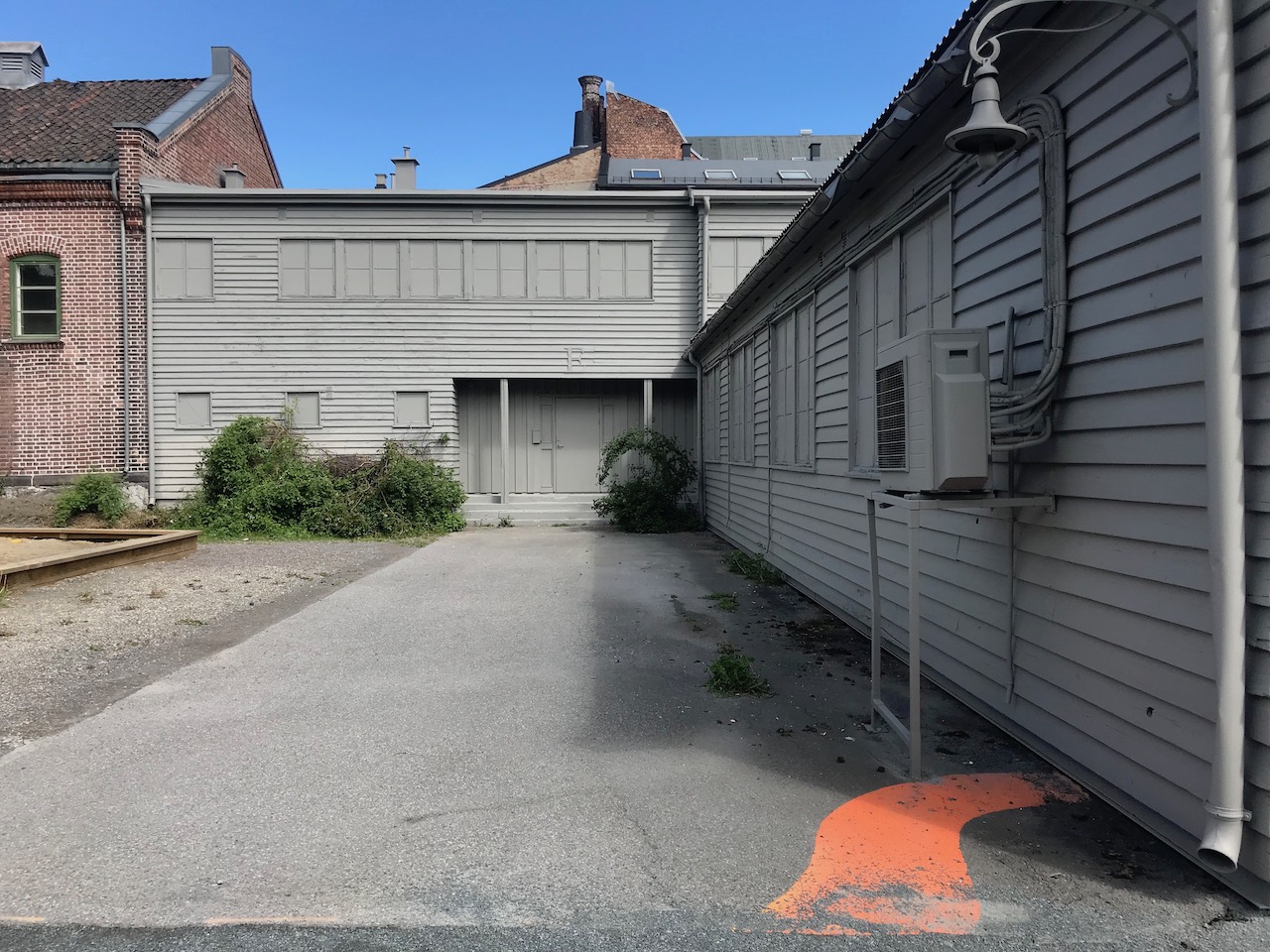
This brings us to the heart of what it is that decides whether or not an artwork in public space is a success. To my mind, if an artwork is to function, few things are more important than how firmly it is anchored in its surroundings and the extent to which it relates to them. One of the few stipulations for the Oslo Biennial artists is that their work should relate to the urban space. Even so, my impression is that the link between the work and the place was in many cases weak. For example, Mette Edvarden’s library of “living books” was a rewarding experience in itself, but the reason why it was located in the biennial’s headquarters in Myntgata would appear to be primarily practical. Furthermore, when one learns that the project Time has fallen asleep in the afternoon sunshine has been set up in many cities both nationally and internationally since it was first presented in 2010, it somehow seems less important in terms of either time or place. One could say that the American Gaylen Gerber succeeds in adding an ingenious eye-catcher to the urban space by painting every nook and cranny of the “German Barracks” in the Myntgata block a uniform grey, but wouldn’t it have been more interesting if the intervention had told us something about the building’s history, function or prospects (I understand there are plans to demolish it)?
Most striking, however, is the absence of local anchorage in the case of the French mediator and designer Benjamin Bardinet, who even presents a map. Bardinet is worried that modern technologies such as GPS reduce the wonder and excitement one can experience when exploring a new place. His contribution is therefore “a map in which we can get lost (…) with quotations, facts and rumours related to the exhibited works, a map that opens up new paths, detours or dead ends”, as it says in the programme. Even so, the work seems unmotivated, because the “map” does not refer to any actual, physical places, either known or unknown. It is designed to resemble a map at first glance, but contains only cursory information about the works of other biennial participants. And the references to situationism are so overstated that they seem like instructions thrust upon us. While Bardinet’s map may be intended as a kind of tool to help us build webs of association around the art of the biennial, I see it more as a cross between some kind of promotional material and a chummy internal gesture to the other artists. In this respect, it merely strengthens the impression that the organisers have focused more on accommodating the general, personal artistic approaches of the participants than on the potential of the respective (public) spaces.
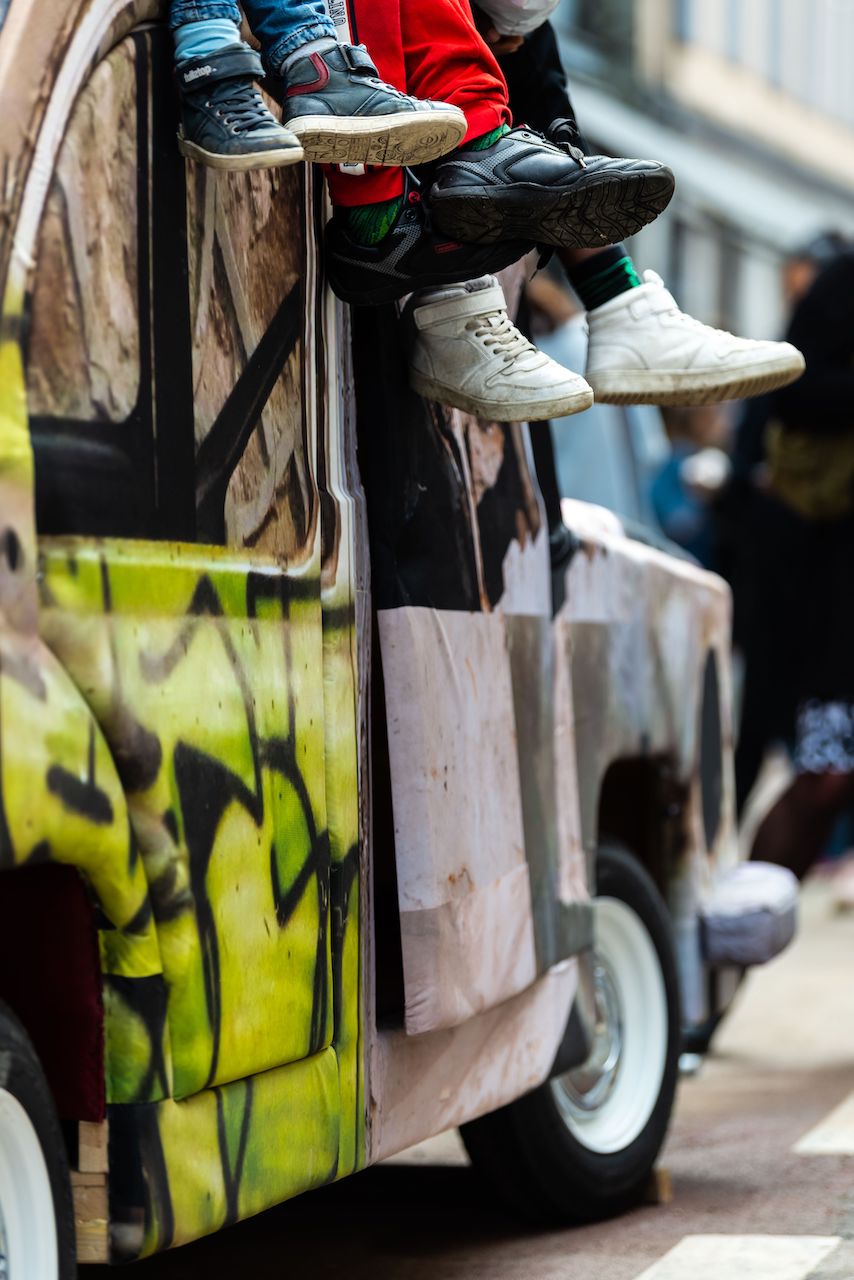
Admittedly, there is nothing easy about developing art that works both in and with the urban space, where such a range of variables must be taken into account. On the other hand, when it succeeds, the art form has immense potential. Decisive in this respect are the processual and temporal qualities. Where the Oslo Biennial is concerned, however, the processual has sometimes been foregrounded at the expense of anchoring in the place. At least, it would seem that this is what happened in the case of British artist Ed D’Souza’s Migrant Car, a copy of a Hindustan Ambassador, a model of car popular in India. D’Souza’s version is made of wood and covered with fabric printed to represent a car wreck. On various occasions it has been rolled around the city, but during my two days in Oslo it was parked on the grass verge outside the offices in Myntgata. As thematic links, the glaring contrast between the car-free centre of Oslo and the chronic gridlock in major Indian cities together with the car’s potential role as an ambassador can, at this point, seem somewhat shallow. But as the car is moved to new locations, it will presumably accumulate further layers of meaning. According to the Artnet website, there are plans to take the car for a roll both in the forthcoming Pride Parade and later along Norway’s border with Russia.**
Although the Oslo Biennial has room for improvement, the bold approach to the experimental, processual and temporary properties of art that the curators and, by extension, Oslo Municipality have shown amounts to an example to follow, not least by the “Trondheim model”. For when public art has to be permanent, as it has largely been in Trondheim, it is easy to get stuck in a safe zone, where you don’t dare to produce anything other than pleasing eye-catchers. One can hardly get further away from art’s full potential. On the other hand, when the art is temporary, it is easier to take a chance on making it challenging and on giving it contemporary relevance and thematic anchorage by letting it engage in a living dialogue with its surroundings.
Hopefully this will change during the renewal of Nyhavna in Trondheim. Berit Kirksæther of Trondheim municipality’s office for public art has brought in the curators Katja Aßmann from Germany and Anne-Gro Erikstad to draw up an art plan for the area, which at present is characterised by industry and cultural monuments from World War II. It has already been stipulated that the constituent projects in the revitalisation of the district will involve other forms of art than those associated with public art in the past. The Ars Situare-inspired walk with Oddvar I.N. Daren and Leiken Vik as part of the Hendelser på Nyhavna programme (Events at Nyhavna) on 15th June was a taste of things to come. In addition, thanks to the “Breisia” initiative, cultural players have come together to ensure that the area will continue to be a place for cultural and small-scale production, as Martin Palmer writes in the ArtScene Trondheim commentary Er det håp for Nyhavna? (Is there hope for Nyhavna?).

Trondheim municipality’s attitude to the temporary and the durable in art is at last beginning to change, and over the next few years the “Trondheim model” will be reassessed. It will be interesting to follow what happens, while players like the Oslo Biennial are finding their feet. In October this year, the latter will be topped up with new contributions from other artists, while several of the existing works are likely to have matured, possibly in unexpected ways. Hopefully by that time the city and the arts will have strengthened their bonds so that each lends greater conviction to the other.
The Oslo Biennial 2019–2024
Participants in part one: Mikaela Assolent, Benjamin Bardinet, Julien Bismuth, Carole Douillard, Ed D’Souza, Mette Edvardsen, Jan Freuchen, Jonas Høgli Major, Sigurd Tenningen, Gaylen Gerber, Hlynur Hallsson, Rose Hammer, Marianne Heier, Michelangelo Miccolis, Mônica Nador and Bruno Oliveira, Michael Ross, Lisa Tan.
Article photo: Michael Ross, The longest day (…), Oslo Biennial. Photo: AST.
*Morgenbladet: “Vi sier at vi driver med byinnvikling, ikke byutvikling”, 24.05.19.
**Artnet: “The Oslo Biennale, Which Will Unfold Across the City over Five Years, Reimagines What Public Art Can Be”, 28.05.19.
Translation by Peter Cripps.
The English text is financed by Trondheim municipality.
